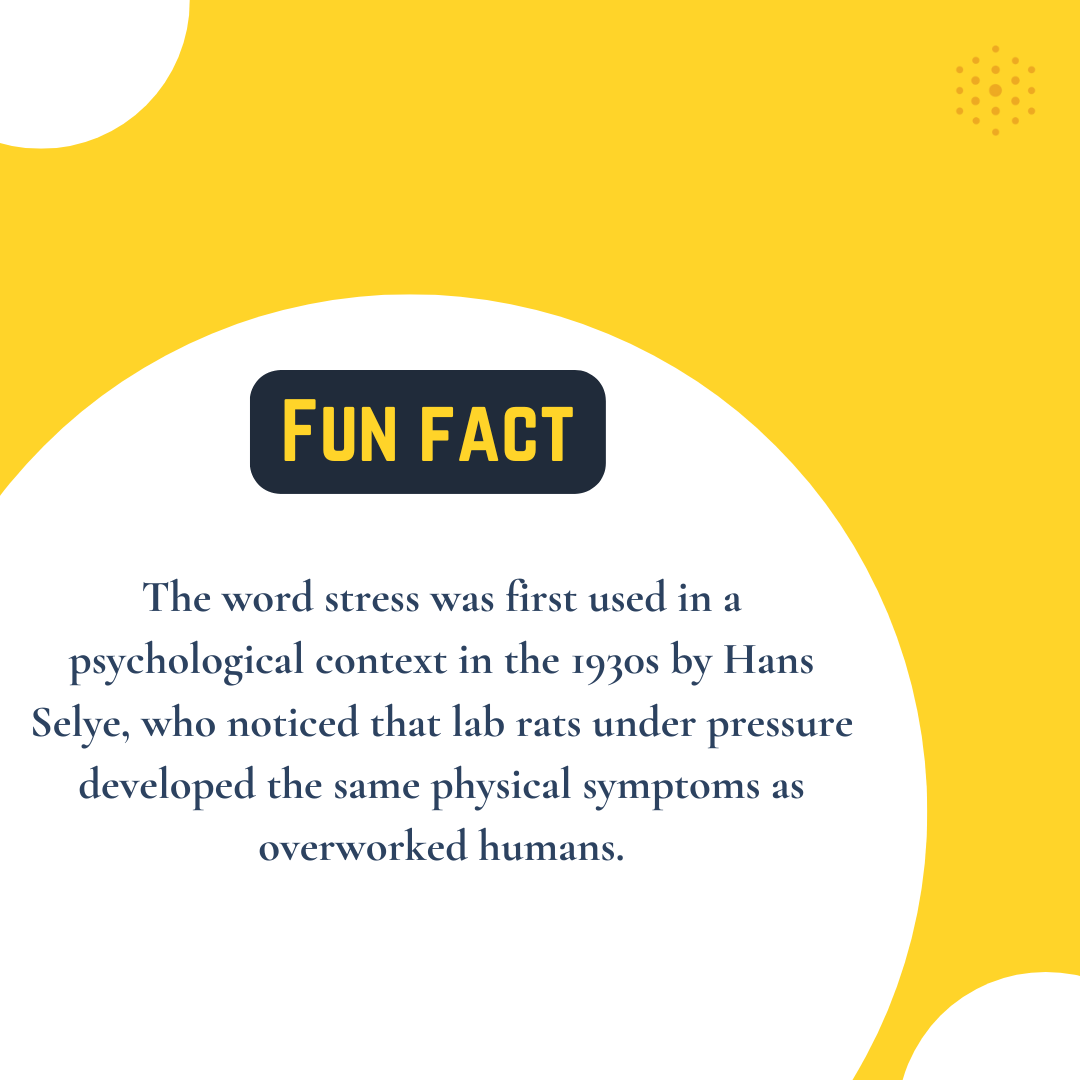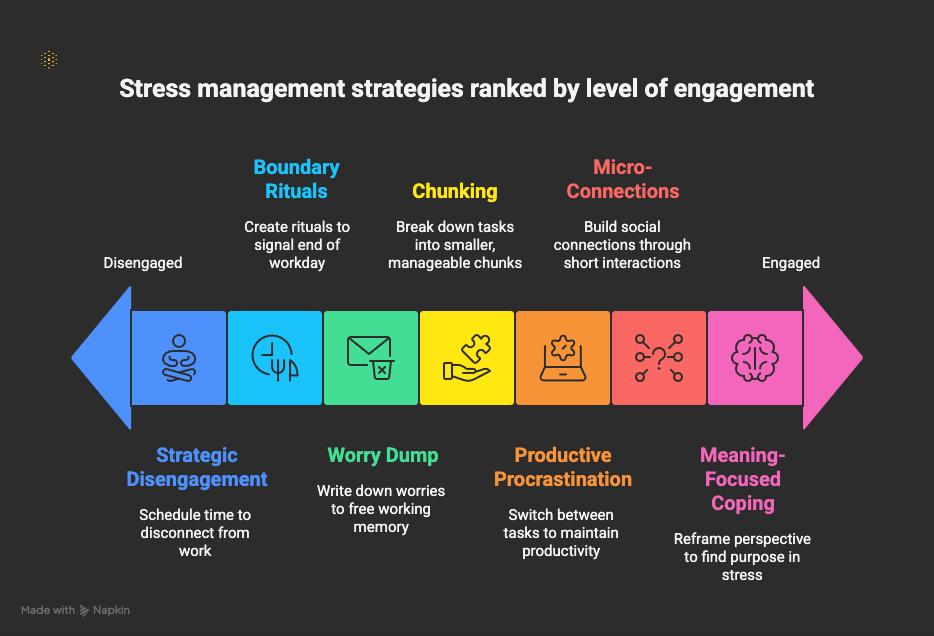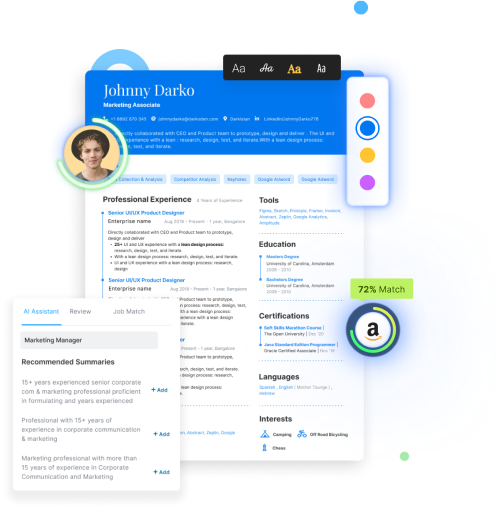What actually helps when work pressure spikes?
Beyond sleep and meditation, seven research-backed tactics can lower stress and keep you effective under load: a quick “worry dump” to clear mental clutter, productive procrastination to rotate tasks without losing momentum, boundary rituals to switch off, meaning-focused reframing to reduce threat, micro-connections for social buffering, task “chunking” to beat overwhelm, and scheduled strategic disengagement to recharge. These approaches translate directly to deadline days.
Let's be honest, most articles on work pressure tell you to meditate, drink water, and get more sleep.
While that's all good advice, it doesn't always cut it when you're staring down a deadline, juggling multiple projects, or dealing with a difficult boss.
Work-related stress is a serious issue. In fact, a staggering 77% of people are affected by work-related stress, according to APA.
It's time for a new approach.
Here are 7 unconventional yet highly effective coping mechanisms to help you manage work pressure, backed by research.
1. The 'Worry Dump': A Pre-emptive Strike Against Anxiety
Instead of letting anxious thoughts about your workload swirl in your head all day, give them a designated outlet.
Before you start a high-pressure task or a big exam, take 10 minutes to write down all your worries and anxieties about it.
This "worry dump" technique offloads your ruminations and frees up your working memory to focus on the task at hand.
Also Read: What are some low stress jobs for people with anxiety?
2. Practice 'Productive Procrastination'
This isn't about scrolling through social media instead of working.
Productive procrastination is about strategically switching between tasks to maintain a high level of productivity and reduce stress.
When you hit a wall with a high-pressure project, instead of forcing yourself to push through, switch to a less demanding, but still productive, task for a short period.
This could be organizing your files, answering a few emails, or brainstorming for a future project.
This approach gives your brain a much-needed break from the stressful task, allowing you to come back to it with a fresh perspective and renewed focus.
With 39% of workers citing workload as their main cause of stress, according to the American Institute of Stress, finding smart ways to manage your tasks is key.
Also Read: What are some the highest paying low stress jobs?
3. Implement 'Boundary Rituals'
In a world where it's easy to be available 24/7, creating clear boundaries between work and home life is crucial.
But instead of just saying "I won't check emails after 6 pm," create a "boundary ritual" to signal to your brain that the workday is over.
This could be a 10-minute walk after you log off, changing out of your work clothes, or listening to a specific playlist on your commute home.
These rituals help you mentally disconnect from work, reducing the risk of burnout.
The American Psychological Association emphasizes the importance of "switching off" from work to avoid the negative effects of chronic stress.
A strong work-life balance is not only good for your mental health but also helps you stay productive.

4. Embrace 'Meaning-Focused Coping'
Sometimes, you can't change the stressful situation, but you can change how you perceive it.
Meaning-focused coping involves finding a sense of purpose or a silver lining in a stressful situation.
This isn't about toxic positivity, but about reframing your perspective.
For example, if a challenging project is causing you stress, focus on the new skills you're developing or how this experience will contribute to your career growth.
This cognitive strategy helps you manage the meaning of the situation, making it feel less overwhelming.
Research from the NCBI suggests that problem-focused and meaning-focused coping strategies can be highly beneficial.
5. Leverage the Power of 'Micro-Connections'
When you're feeling the pressure, your first instinct might be to isolate yourself and power through.
However, building and maintaining social connections at work can be a powerful buffer against stress.
You don't need to have deep, personal conversations with all your colleagues. "Micro-connections" - short, positive interactions, can make a big difference.
A quick chat by the coffee machine, a friendly "hello" in the hallway, or a positive comment in a team meeting can help you feel more connected and supported.
Also Read: What are some common employee benefits?
6. Adopt a 'Chunking' Approach to Your To-Do List
Multitasking is often seen as a badge of honor in a busy workplace, but it can actually increase stress and decrease productivity.
Instead of juggling multiple tasks at once, try "chunking."
Chunking involves breaking down large projects into smaller, more manageable tasks and focusing on one "chunk" at a time.
This approach not only makes your to-do list less daunting but also gives you a sense of accomplishment as you complete each small task.
This is a core principle of effective project management.
The cognitive strategy of chunking helps you stay organized and reduces the "frazzled" feeling that comes with multitasking.
7. Schedule 'Strategic Disengagement'
Just as you schedule meetings and deadlines, it's important to schedule time for "strategic disengagement."
This is dedicated time in your calendar where you completely disconnect from work-related thoughts and activities.
This could be a 15-minute break in the middle of the day to read a book, a dedicated hour in the evening for a hobby, or a weekend where you don't check your work phone at all.
The key is to be intentional about it. The American Psychological Association highlights that taking time to recharge is critical to avoid burnout and return to your pre-stress level of functioning.
Also Read: How to become a poly professional?

Final Thoughts
Work pressure will always be part of the modern workplace, but how you manage it determines whether it drains you or drives you.
By adopting approaches like worry dumps, boundary rituals, and strategic disengagement, you give yourself space to perform at your best.
At Hiration, we bring the same philosophy to careers - helping professionals create standout resumes, practice interviews with AI-driven feedback, and refine LinkedIn profiles so they can focus on growth, confidence, and opportunities that matter most.
Ultimately, it’s about finding approaches that let you stay focused, balanced, and ready for what comes next.
Work Stress — Research-Backed Coping FAQ
What is a “worry dump,” and how do I do it?
Before a high-stakes task, set a 10-minute timer and write every concern, worst-case thought, and open loop. Don’t edit—just empty your head. Then start the task. This offloads ruminations and frees working memory so you can focus. (Claim source attribution: technique described in your draft; I have not independently verified study specifics.)
Is “productive procrastination” just avoidance with a nicer name?
No—switch intentionally to a lower-cognitive-load task that still moves work forward (e.g., quick inbox triage, filing, outline tweaks). Cap it (e.g., 15–25 minutes), then return to the main task. The goal is to preserve momentum and reduce stress, not to escape responsibility.
What are examples of effective boundary rituals after work?
3–10 minute cues that tell your brain “work is over”: a short walk, changing clothes, a shutdown checklist (“capture, plan, shutdown”), or a commute playlist. Consistent rituals aid detachment and reduce chronic stress. (General principle aligns with psychological detachment research; not independently verified here.)
How is meaning-focused coping different from “toxic positivity”?
Meaning-focused coping reframes stressors by connecting them to values, growth, or skills gained—without denying difficulty. Toxic positivity dismisses legitimate strain. A balanced reframe might be: “This timeline is tough, and it’s sharpening my stakeholder management.”
Do tiny “micro-connections” at work really reduce stress?
Brief, positive interactions (a hello, quick thanks, 60-second check-in) can buffer stress by restoring a sense of support and belonging. This is useful for in-office and remote teams (think short Slack kudos or camera-on greetings).
How do I use “chunking” to make a big project feel doable?
Break the project into 30–90-minute chunks with clear, observable outcomes (e.g., “draft intro + bullets,” not “work on report”). Start with the smallest meaningful chunk to create momentum, then stack chunks across the day.
What does “strategic disengagement” look like on a calendar?
Schedule short, full detachment blocks: a 10–15 minute mid-day reset (stretch, read, breathe), a hobby hour in the evening, or device-free blocks on weekends. Treat them like meetings—protected and recurring—to restore baseline functioning.
My manager expects instant replies—how can I set boundaries?
Share availability windows and a simple SLA (“I respond within 2 hours 9–6; for urgent items, call”). Use status notes, delayed send, and a daily wrap-up note to reduce after-hours pings while maintaining reliability.
What’s a 5-minute reset I can use between back-to-back meetings?
Step away from screens, sip water, 60–90 seconds of box breathing (4-4-4-4), jot the top next action for the upcoming meeting, and stand/stretch. Tiny resets reduce cumulative stress and decision fatigue.
When should I seek professional help for work stress?
If stress persists for weeks, impacts sleep/appetite, causes panic symptoms, or affects relationships and performance, consult a licensed clinician. If you’re in crisis, seek local emergency support immediately.



